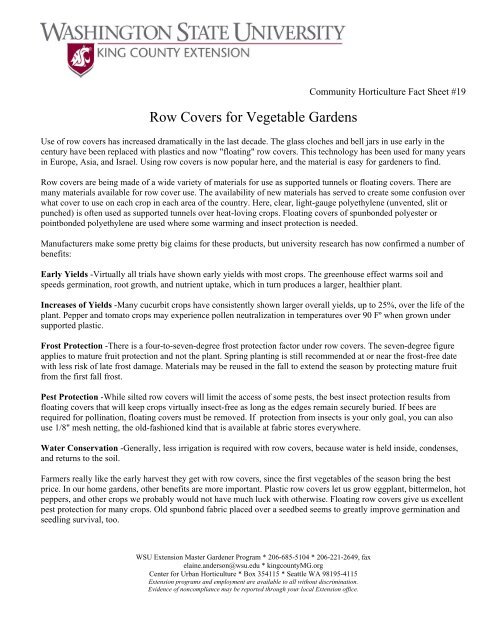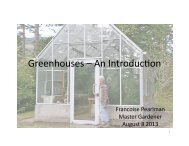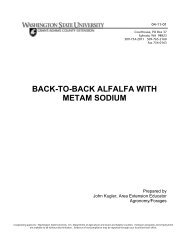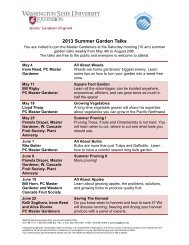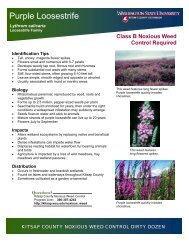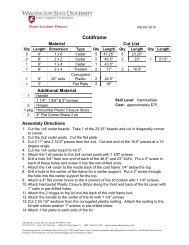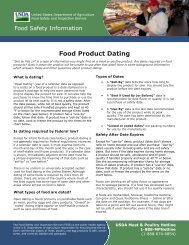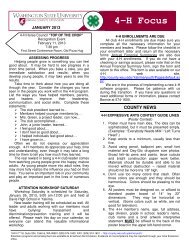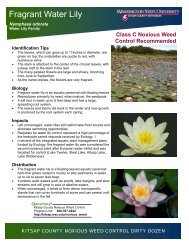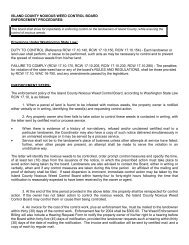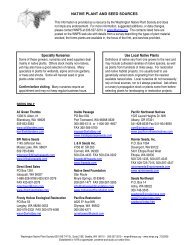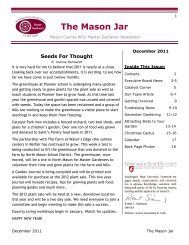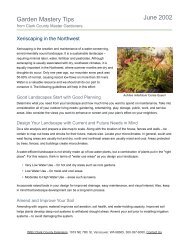Row Covers for Vegetable Gardens - WSU Extension Counties
Row Covers for Vegetable Gardens - WSU Extension Counties
Row Covers for Vegetable Gardens - WSU Extension Counties
You also want an ePaper? Increase the reach of your titles
YUMPU automatically turns print PDFs into web optimized ePapers that Google loves.
<strong>Row</strong> <strong>Covers</strong> <strong>for</strong> <strong>Vegetable</strong> <strong>Gardens</strong><br />
<strong>WSU</strong> <strong>Extension</strong> Master Gardener Program * 206-685-5104 * 206-221-2649, fax<br />
elaine.anderson@wsu.edu * kingcountyMG.org<br />
Center <strong>for</strong> Urban Horticulture * Box 354115 * Seattle WA 98195-4115<br />
<strong>Extension</strong> programs and employment are available to all without discrimination.<br />
Evidence of noncompliance may be reported through your local <strong>Extension</strong> office.<br />
Community Horticulture Fact Sheet #19<br />
Use of row covers has increased dramatically in the last decade. The glass cloches and bell jars in use early in the<br />
century have been replaced with plastics and now "floating" row covers. This technology has been used <strong>for</strong> many years<br />
in Europe, Asia, and Israel. Using row covers is now popular here, and the material is easy <strong>for</strong> gardeners to find.<br />
<strong>Row</strong> covers are being made of a wide variety of materials <strong>for</strong> use as supported tunnels or floating covers. There are<br />
many materials available <strong>for</strong> row cover use. The availability of new materials has served to create some confusion over<br />
what cover to use on each crop in each area of the country. Here, clear, light-gauge polyethylene (unvented, slit or<br />
punched) is often used as supported tunnels over heat-loving crops. Floating covers of spunbonded polyester or<br />
pointbonded polyethylene are used where some warming and insect protection is needed.<br />
Manufacturers make some pretty big claims <strong>for</strong> these products, but university research has now confirmed a number of<br />
benefits:<br />
Early Yields -Virtually all trials have shown early yields with most crops. The greenhouse effect warms soil and<br />
speeds germination, root growth, and nutrient uptake, which in turn produces a larger, healthier plant.<br />
Increases of Yields -Many cucurbit crops have consistently shown larger overall yields, up to 25%, over the life of the<br />
plant. Pepper and tomato crops may experience pollen neutralization in temperatures over 90 Fº when grown under<br />
supported plastic.<br />
Frost Protection -There is a four-to-seven-degree frost protection factor under row covers. The seven-degree figure<br />
applies to mature fruit protection and not the plant. Spring planting is still recommended at or near the frost-free date<br />
with less risk of late frost damage. Materials may be reused in the fall to extend the season by protecting mature fruit<br />
from the first fall frost.<br />
Pest Protection -While silted row covers will limit the access of some pests, the best insect protection results from<br />
floating covers that will keep crops virtually insect-free as long as the edges remain securely buried. If bees are<br />
required <strong>for</strong> pollination, floating covers must be removed. If protection from insects is your only goal, you can also<br />
use 1/8" mesh netting, the old-fashioned kind that is available at fabric stores everywhere.<br />
Water Conservation -Generally, less irrigation is required with row covers, because water is held inside, condenses,<br />
and returns to the soil.<br />
Farmers really like the early harvest they get with row covers, since the first vegetables of the season bring the best<br />
price. In our home gardens, other benefits are more important. Plastic row covers let us grow eggplant, bittermelon, hot<br />
peppers, and other crops we probably would not have much luck with otherwise. Floating row covers give us excellent<br />
pest protection <strong>for</strong> many crops. Old spunbond fabric placed over a seedbed seems to greatly improve germination and<br />
seedling survival, too.
There are a few other details you should know about row covers.<br />
Wind Protection -In very windy areas, supported tunnels may be necessary, because floating covers may cause crop<br />
damage by rubbing on plants.<br />
Mulch - Black plastic mulch is recommended <strong>for</strong> use under row covers to retard weed growth. Pulling back the row<br />
cover to weed the crop is a hassle,and mulch will allow you to do it less frequently. There are a few reports of the<br />
black plastic "frying" transplants in other parts of the Northwest, but there are no reports of that problem here.<br />
How Long to Cover -We still don't have good guidelines here. - four to five weeks on spring-seeded, cool-weather<br />
crops and longer on crops that appreciate warmth. You must remove row covering at flowering to get bee pollination<br />
of squash-family plants. You may as well remove it at harvest time of tomatoes and other fruiting crops to make<br />
picking easier and to increase light levels in late summer.<br />
Crop researchers at <strong>WSU</strong> (Northwest Washington Research and <strong>Extension</strong> Center, Mt. Vernon) and OSU (Corvallis)<br />
have experimented with a number of crops under row covers in the Northwest.<br />
• Cabbage, celery, cauliflower, endive, kohlrabi, leek - Significantly enhanced earliness (1-3 weeks) <strong>for</strong> all crops.<br />
Excellent protection from insect pests.<br />
• Lettuce - Significantly increased yields, up to 60%. Increasing covering time has been shown to increase yields.<br />
• Melons - Significantly enhanced earlier yields (5-28 days) with peak harvest 7 days early.<br />
• Onions - Significantly increased total yields, up to 42%.<br />
• Peas - Significantly increased total yields, up to 47%.<br />
• Peppers - Experienced varying results with most significant being earliness (7-10 days).<br />
• Squash - Enhanced earliness and excellent pest protection.<br />
• Sweet corn - Enhanced crop earliness with significant increase in total yields (30-60%).<br />
• Tomatoes - Experienced varying results from negative effects on yields to increased (45-60%) early yields and<br />
total yields (10-20%).<br />
Last but not least, there was one trial done in New England that came up with some interesting results you might like<br />
to know about even though it doesn't involve Northwest conditions. In New Hampshire, plots were seeded in October<br />
with nine varieties of lettuce and three of spinach. By spring, those plots with floating row covers had perfect stands of<br />
lettuce and spinach. Without cover, not a single plant survived the winter. The researchers admit they don't understand<br />
why there was such dramatic protection, since the temperatures recorded under the cover were the same as without a<br />
cover (-2 degrees Fº.) They theorize that frost heaving and drying was less severe under the material and are<br />
continuing their trials.<br />
<strong>WSU</strong> <strong>Extension</strong> Master Gardener Program * 206-685-5104 * 206-221-2649, fax<br />
elaine.anderson@wsu.edu * kingcountyMG.org<br />
Center <strong>for</strong> Urban Horticulture * Box 354115 * Seattle WA 98195-4115<br />
<strong>Extension</strong> programs and employment are available to all without discrimination.<br />
Evidence of noncompliance may be reported through your local <strong>Extension</strong> office.<br />
3/10


